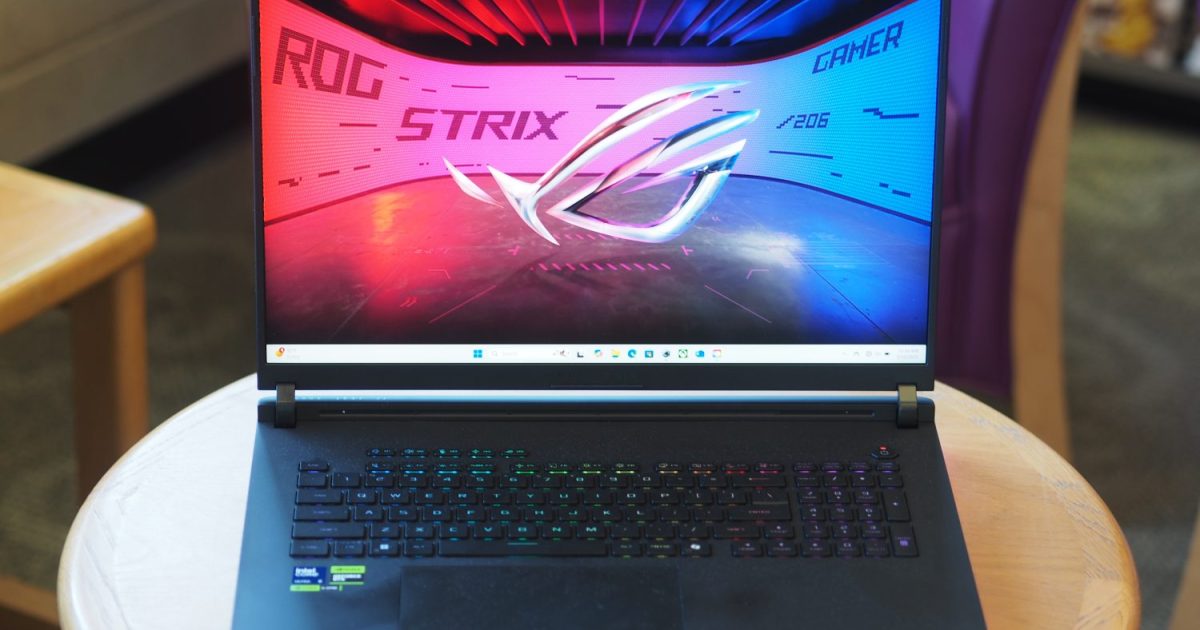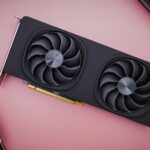Asus ROG Strix SCAR 18 2025
MSRP $3,400.00
“The Asus ROG Strix SCAR 18 2025 is very large, and very great.”
Pros
- Spectacular mini-LED display
- Very fast gaming performance
- Excellent creativity performance
- Solid build quality
- Attractive gaming aesthetic
- Good gaming keyboard
Cons
- Expensive
- Very large and heavy
- Touchpad is disappointing
I’ve now reviewed my second laptop built around Intel’s newest Arrow Lake-HX chipset and Nvidia’s Blackwell GPU architecture. The first, the Lenovo Legion Pro 7i, was very fast and lived up to the hype, while being a very large 16-inch gaming laptop with some nice aesthetic flair.
The second is the Asus ROG Strix SCAR 18, and it’s even larger, with a spectacular 18-inch mini-LED display that’s the best one I’ve reviewed yet. It’s also very fast, although a tiny bit behind, and it, too, offers up a lot to gamers looking for a great, kind of portable gaming machine.
Specs and configurations
| Asus ROG Strix SCAR 18 2025 | |
| Dimensions | 15.71 x 11.73 x 0.93-1.26 inches |
| Weight | 7.28 pounds |
| Processor | Intel Core Ultra 9 275HX |
| Graphics | Nvidia GeForce RTX 5070 Ti Nvidia GeForce RTX 5080 Nvidia GeForce RTX 5090 |
| RAM | 16GB DDR5-5600 32GB DDR5-5600 |
| Display | 18.0-inch 16:10 QHD+ (2560 x 1600) mini-LED, 240Hz |
| Storage | 1TB SSD 2TB SSD |
| Touch | No |
| Ports | 2 x USB-C with Thunderbolt 5 3 x USB-A 3.2 Gen 2 1 x HDMI 2.1 1 x 2.5G RJ45 1 x 3.5mm audio |
| Wireless | Wi-Fi 7 and Bluetooth 5.4 |
| Webcam | 1080p with infrared camera for Windows 11 Hello |
| Operating system | Windows 11 |
| Battery | 90 watt-hour |
| Price | $2,700+ |
The ROG Strix SCAR 18 will be available in a few configurations, only some of which are available as this review is being written. The base model will include an Intel Core Ultra 9 275HX chipset, which is common to all configurations, along with 16GB of RAM, a 1TB SSD, a 16.0-inch QHD+ mini-LED display (the only option), and an Nvidia GeForce RTX 5070 Ti. Upgrading to an RTX 5080 and a 2TB SSD brings the price to $3,400, while an RTX 5090 boosts the price to $4,500.
Those are expensive prices, but of course, you get a lot of gaming laptop. It’s a lot more expensive than the Legion Pro 7i, which comes in at $3,399 with a Core Ultra 9 275HX, 32GB of RAM, two 1TB SSDs, the RTX 5080, and a 16.0-inch QHD+ OLED display. But I imagine much of that price difference is down to the larger and very good mini-LED panel that Asus is using with the ROG Strix SCAR 18.
Design

There’s no way around it: the ROG Strix SCAR 18 is a very large laptop. Of course, packing so much power into a chassis that also needs to house an 18.0-inch display would be pretty hard to do and keep things svelte at the same time. The Razer Blade 18 is a little thinner at 1.1 inches versus 1.26 inches, and lighter at 7.06 pounds versus 7.28 pounds. But these 18-inch gaming laptops are just big. You’ll have to deal with it if you want such a large display that can be carried around in one piece.
The ROG Strix SCAR 18 is constructed of a mix of materials, including aluminum in the keyboard deck and plastic in the bottom chassis and lid. It’s solid enough, with no bending, flexing, or twisting. I’m sure the Razer Blade 18 might come across as better made, given Razer’s devotion to make the most MacBook Pro-like gaming laptops. But there’s nothing wrong with Asus’s construction.

In terms of its aesthetics, the ROG Strix SCAR 18 incorporates most of the things gamers want to see in their machines. First, there’s plenty of RGB lighting, including the per-key RGB lighting on the keyboard, the full-surround RGD LED’s lining the underside of the chassis all the way around, and the large ROG logo on the lid that pulses according to what’s setup in the Armoury Crate utility. And the white Asus AniMe Vision LEDs on the lid are quite striking, showing a variety of present and custom messages that flow like a high-tech ticker tape.

At the same time, the overall design doesn’t include some of the more aggressive gamer touches like jet fighter exhaust venting on the back. The vents on the ROG Strix SCAR 18 are more pedestrian and functional, and neither add to nor detract from the overall gamer aesthetic. The Lenovo Legion Pro 7i has RGB LED lighting around its fighter jet exhausts and it looks pretty cool. The ROG Strix SCAR 18 lacks those kinds of touches. Whether that matters will be down to individual tastes.
Overall, I like the design. Yes, it’s large and bulky, but like I said, that’s really unavoidable.
Keyboard and touchpad

The ROG Strix SCAR 18 keyboard is a bit of a mixed bag. As mentioned above, it has per-key RGB lighting that looks great. And it’s pretty expansive, even with the numeric keypad for macro binding in various games. If found the keycaps oddly small, though, which made it harder than necessary to keep my fingers on home row. And the switches are deep and springy enough for gaming, but not quite as satisfying as I like. I didn’t really enjoy typing this review on the keyboard, but gamers will probably find it good enough, if not the best they’ve used.
The touchpad was disappointing. It’s large, but the buttons weren’t very responsive. I took to using an external mouse because I found myself repeatedly trying to click to get things done, and it was frustrating. Most gamers will use gaming mice, so that’s probably not as much of an issue. But it’s certainly not a strength.
Connectivity and webcam
There’s plenty of connectivity, with a mix of ultramodern Thunderbolt 5 ports and legacy connections. That includes a 2.5G RJ45 Ethernet port, which will be appreciated for those who don’t want to game wirelessly. My biggest complaint is that all the ports are on the side, where putting them on the back would keep them out of the way. Wireless connectivity is fully up-to-date.
The webcam is a 1080p version, and it’s fine. It has an infrared camera for Windows 11 Hello facial recognition, which I appreciate. The Arrow Lake-HX chipset doesn’t have a fast Neural Processing Unit (NPU), and so the ROG Strix SCAR 18 isn’t a Microsoft Copilot+ PC laptop. That’s probably fine, because if you want to use this laptop for AI processing, you’ll want to use the incredibly fast Nvidia Blackwell GPU.
Performance

This is just the second laptop I’ve reviewed with Intel’s Arrow Lake-HX chipset, the Core Ultra 9 275HX. It has 24 cores (eight Performance and 16 Efficient), running at up to 5.4 GHz and consuming 55 watts of power, boosting to a maximum of 160 watts. Asus gives it up to 65 watts in its configuration. The Core Ultra 9 275HX is a very fast chipset, with slightly faster cores that result in slightly faster multi-core scores over the previous generation Core i9-14900HX with around the same basic specs. I noticed a discrepancy between Asus’s web site where it says the CPU can get up to 80 watts, while my press materials say it’s 65 watts.
The Strix SCAR 18 is also the second I’ve reviewed with an Nvidia Blackwell 5000-series GPU, the GeForce RTX 5080. It has Nvidia’s newest CUDA cores, streaming multiprocessors, and RT and tensor cores, and it powers Nvidia’s DLSS 4 that leverages on-device AI processing speeds for much faster scaling and frame generation with an eye toward dramatically improving visual quality while running at similar framerates to the previous generation. It also boosts performance in tasks like video editing with advanced encoding/decoding engines. Asus gives the RTX 175 up to 175 watts, totaling 240 watts — just a bit less than the 250 watts Lenovo gives to the Legion Pro 7i. Again, that’s per my press materials, while the Asus web site says it’s up to 255 watts. If I can get that clarified, I’ll update the review.
Asus includes its Armoury Crate utility that provides finder control over performance than Lenovo’s LegionSpace utility in the Legion Pro 7i. In addition to several performance-based presets, you can enter a manual mode where you can get more granular in configuring the CPU and GPU. I didn’t dig into the settings, but they there for anyone who wants to fully optimized performance. In our benchmarks, I used the Windows, Performance, and Turbo settings and reported the latter in the table below.
The Asus ROG Intelligent Cooling system makes great use of all that interior space, with an end-to-end vapor chamber, triple fans, and Liquid Metal helping to keep things cool. The fans spun up during intense sessions, especially in Turbo mode, but they were slightly quieter than with the Legion Pro 7i. I’ve used gaming laptops that were a lot louder and where the fan noise was harsher.

In our standard suite of benchmarks, the two Arrow Lake-HX/Blackwell laptops perform similarly, with the Lenovo machine being slightly faster across the board. That might be down to either the slight increase in power or more aggressive tuning. Both are much faster than previous generation Windows laptops in most of our benchmarks, with only the Asus ROG Flow Z13 (a very diminutive machine) being faster in Geekbench 6 multi-core with its AMD Ryzen AI MAX+ 935 chipset. But there’s no doubt that the Strix SCAR 18 will be very fast for the most demanding productivity tasks.
Creative professionals looking for a fast Windows laptop for photo editing and video editing, along with users that use 3D design and rendering software, often look to gaming laptops given their high-end components and focus on pure performance. The Pugetbench Premiere Pro and Photoshop benchmarks run in the live versions of each Adobe app and give a good indication of a laptop’s performance for demanding creators. The Strix SCAR 18 is very fast in both, even beating out the Apple MacBook Pro 16 in the Premiere Pro benchmark where the M4 Max chipset benefits from fast encoding/decoding circuitry. Again, the Legion Pro 7i was faster.
| Geekbench 6 (single/multi) |
Handbrake (seconds) |
Cinebench R24 (single/multi/GPU) |
PCMark 10 Complete |
PugetBench Premiere Pro |
Pugetbench Photoshop |
|
| Asus ROG Strix SCAR 18 (2025) (Core Ultra 9 275HD /RTX 5080) |
3,050 / 18,876 | 35 | 133 / 1,998 / N/A | 8,601 | 9,867 | 8,486 |
| Lenovo Legion Pro 7i (2025) (Core Ultra 9 275HX / RTX 5080) |
3,136 / 20,228 | 33 | 135 / 2,054 / N/A | 9,361 | 10,377 | 9,087 |
| Lenovo Legion 9i Gen 9 (Core i9-14900H / RTX 4090) |
1,873 / 13,175 | 71 | 117 / 916 / 8,873 | 9,122 | N/A | 6,622 |
| Asus ROG Strix 18 (Core i9-14900HX / RTX 4090) |
2,946 / 17,622 | N/A | Bal: 124 / 1,533 / 22,067 | N/A | 7,430 | N/A |
| Asus ROG Flow Z13 (Ryzen AI MAX+ 395 / Radeon 8060S) |
2,993 / 20,659 | 36 | 121 / 1,568 / NA | N/A | 7,250 | 7,250 |
| Alienware m16 R2 (Core Ultra 7 155H / RTX 4070) |
2,366 / 12,707 | N/A | 103 / 1,040 / 10,884 | 7,028 | 5,590 | 5,590 |
| Apple MacBook Pro 16 (M4 Max 16/40) |
3,626 / 25,332 | 48 | 179 /2,072 / 16,463 | N/A | 9,347 | 13,856 |
Gaming

As mentioned above, the Nvidia Blackwell 5000-series is aimed at providing comparable framerates to the previous 4000-series GPUs, but dramatically enhancing visual quality. It does this by using various AI-powered processes for upscaling and frame generation, using Blackwell’s very fast AI performance. The visual improvements are striking, for sure, but we don’t currently benchmark performance using any games that fully support DLSS 4 and so will show off the visual impact.
So far, the two RTX 5080 laptops I’ve reviewed have been very fast, but not necessarily much faster in various games than previous 4000-series laptops. Which is to say, you’re not giving up performance across the board, you’re getting much better visual quality, and you’ll see performance increases as games become more optimized. There’s nothing wrong with that. Note that I ran some benchmarks with the Strix SCAR 18 GPU set at the highest setting, but it made no difference in the benchmarks.
In the synthetic 3DMark Time Spy benchmark, the ROG Strix SCAR 18 was slightly behind the Legion Pro 7i, and we’ll see that this pattern held in all of our benchmarks. As with our non-gaming benchmarks, the Asus is just a little slower than the Lenovo. That’s likely down to tuning, but the differences likely won’t be enough to force a decision.
Breaking down by individual games — and all listed results are in each laptop’s highest performance mode — we’ll start with Civilization VI. This title benefits from bother very fast CPU and very fast GPU performance, and like the Legion Pro 7i, the Strix SCAR 18 was very fast at running it.
In Cyberpunk 2077, the Strix SCAR 18 was slightly behind the Legion Pro 7i, while the Lenovo Legion 9i Gen 9 with an RTX 4090 was the fastest in this comparison group. I suspect that the RTX 5090 will take the top spot in this game, although again, I wouldn’t expect a massive increased.
In Red Dead Redemption, the Asus was actually the second-slowest laptop. For whatever reason, it fell further behind than in the other titles. It’s still quite playable at 1600p and Ultra graphics, but this game wasn’t it’s best showing,
Finally, Assassin’s Creed Valhalla showed that the laptops we’ve tested have been around the same level of performance. And it’s very fast.
Overall, once again, the ROG Strix SCAR 18 didn’t break any records, and in fact didn’t keep up with some RTX 4000-series laptops, but it was more than fast enough for most gamers in these older titles. I suspect that these results will only improve.
| 3DMark Time Spy |
Civ VI 1600p Ultra |
CyberPunk 2077 1600p Ultra RT |
Red Dead Redemption 16oop Ultra |
Assassin’s Creed Valhalla 1440p Ultra High |
|
| Asus ROG Strix SCAR 18 (2025) (Core Ultra 9 275HD /RTX 5080) |
19,823 | 273 fps | 70 fps | 87 fps | 122 fps |
| Lenovo Legion Pro 7i (2025) (Core Ultra 9 275HX / RTX 5080) |
21,486 | 296 fps | 77 fps | 94 fps | 127 fps |
| Lenovo Legion Pro 7i (2023) (Core i9-13900HX / RTX 4080) |
18,382 | 223 fps | 45 fps | 99 fps | 126 fps |
| Lenovo Legion 9i Gen 9 (Core i9-14900H / RTX 4090) |
20,293 | N/A | 88 fps | N/A | N/A |
| Asus ROG Zephyrus M16 (Core i9-13900H / RTX 4090) |
18,372 | 191 fps | N/A | 99 fps | N/A |
| Lenovo ThinkPad P1 Gen 6 (Core i7-13800H / RTX 4080) |
13,615 | 170 fps | 57 fps | N/A | N/A |
| Asus ROG Flow Z13 (Ryzen AI MAX+ 395 / Radeon 8060S) |
10,532 | 88 fps | N/A | 73 fps | 67 fps |
Battery life

We test battery life with gaming laptops, and invariably, we reach the same conclusion. These aren’t laptops that you should plan to carry around and use without being plugged in, especially for their primary purpose of gaming which pushes every component to its limits. And then considering the size and weight of the ROG Strix SCAR 18, this isn’t really meant to be carried around all that much at all. You can move it from place to place for gaming sessions, but you’ll be carrying the very large and heavy power brick along with you regardless.
In our web browsing and video looping battery tests, the laptop barely made it to two hours, and in our more demanding Cinebench R24 test, it didn’t make it to an hour. A 90 watt-hour battery just can’t keep up with powerful components and a very power-hungry 18-inch mini-LED display. Just plan on keeping the thing plugged in.
Display and audio

I’ve reviewed a few mini-LED displays, and they all been pretty good. That includes the MacBook Pro 16, which until now has had the best example. The Strix SCAR 18, though, might beat them all in some very important metrics. It’s an 18.0-inch 16:10 QHD+ (2560 x 1600) mini-LED panel running at up to 240Hz. It’s incredibly bright and has brilliant colors. It’s not as sharp as the MacBook Pro 16’s display, being both lower resolution and much larger. But for gamers, it promises outstanding high dynamic range (HDR) performance along with a super fast refresh rate that supports Nvidia G-Sync for tear-free gaming.
My Datacolor SpyderPro colorimeter captured the objective excellence of this panel. It’s incredibly bright at 1,084 nits, which is brighter than the MacBook Pro 16’s 585 nits. Apple’s panel can peak as high at 1,600 nits, but in terms of sustained brightness as measured, the Asus comes out on top. And, its contrast ratio is incredibly hight at 16,310:1, beating out the MacBook Pro 16’s 12,940:1. Both have deep blacks, but the Strix SCAR 18 is a bit deeper. The colors are also wide at 100% sRGB, 89% AdobeRGB, and 100% DCI-P3, with excellent color accuracy at DeltaE 1.05 (less than 1.0 is indistinguishable to the human eye). The MacBook Pro 16 comes in at 100%, 87%, and 99%, respectively, along with DeltaE 1.18.
The one negative of mini-LED versus, say, OLED displays, is that there can be some blooming on bright objects against black backgrounds. I didn’t notice anything significant, and unless you’re in a very dark environment, you may not notice it either. Instead, everything looked spectacular, and HDR content was great. That’s for both gaming and HDR media content. This is a very good display that will show off every game you play, and will take advantage of all the power this laptop provides.
Audio is provided by dual tweeters and downward-firing speakers, and quite frankly, it’s not all that impressive. It gets loud, but there’s some distortion at full volume, and bass was noticeably lacking. I strongly suggest a good pair of gaming headphones — which you’ll probably already plan on using.
A very large, and very awesome, gaming laptop
If you want a gaming machine that you can lug around with you and don’t might the girth and weight, the ROG Strix SCAR 18 will reward you even while it gives you a little exercise. To begin with, the large size is necessary to gain access to that awesome mini-LED display that’s as bright and colorful as any I’ve reviewed — and even better than most.
And then the performance is also excellent, even if it’s not the fastest I’ve reviewed. It will keep up with everything you throw at it, from gaming to creative workflows, without breaking a sweat. It’s not inexpensive, but that’s not to be expected with such a well-designed gaming machine.
Read the full article here














